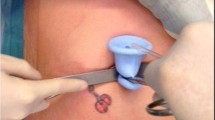Abstract
Introduction
The optimal abdominal incision for partial hepatectomy has not been established.
Methods
A prospective hepatobiliary surgery database was retrospective reviewed. Patients with Mercedes and extended right subcostal (ERSC) incisions were identified and compared.
Results
Between December 1991 and September 2001 a total of 1426 patients met the inclusion criteria. Among them, 856 (60%) had a Mercedes incision and 570 (40%) an ERSC incision. The two groups were well matched for demographics and operative variables. Perioperative morbidity and pulmonary complications were similar for the two groups as well. There was no difference in terms of early wound complications, although incisional hernias occurred in 9.8% of patients with a Mercedes incision compared to 4.8% of those with an ERSC incision (P = 0.0001.) On multivariate analysis, the incision type, along with gender, body mass index, and age, were significant predictors of incisional hernia.
Conclusions
An ERSC incision for partial hepatectomy provides adequate, safe access and is associated with fewer long-term wound complications.

Similar content being viewed by others
References
Kirkland KB, Briggs JP, Trivette SL, et al. The impact of surgical-site infections in the 1990s: attributable mortality, excess length of hospitalization, and extra costs. Infect Control Hosp Epidemiol 1999;20:725–730
Lin KY, Johns FR, Gibson J, et al. An outcome study of breast reconstructions: presurgical identification of risk factors for complications. Ann Surg Oncol 2001;8:586–591
Leaper DJ, Melling AG. Antibiotic prophylaxis in clean surgery: clean non-implant wounds. J Chemother 2001;13:96–101
Nicolle LE, Huchcroft SA, Cruse PJ. Risk factors for surgical wound infection among the elderly. J Clin Epidemiol 1992;45:357–364
Kahan BD. Nutrition and host defense mechanisms. Surg Clin North Am 1981;61:557–570
Malone DL, Genuit T, Tracy JK, et al. Surgical site infections: reanalysis of risk factors. J Surg Res 2002;103:89–95
Meakins JL, Christou NV, Halle CC, et al. Influence of cancer on host defense and susceptibility to infection. Surg Forum 1979;30:115–117
Mangram AJ, Horan TC, Pearson ML, et al. Guideline for prevention of surgical site infection: Hospital Infection Control Practices Advisory Committee. Infect Control Hosp Epidemiol 1999;20:250–278
Halasz NA. Vertical vs horizontal laparotomies. I. Early postoperative comparisons. Arch Surg 1964;88:911–914
Armstrong PJ, Burgess RW. Choice of incision and pain following gallbladder surgery. Br J Surg 1990;77:746–748
Garcia-Valdecasas JC, Almenara R, Cabrer C, et al. Subcostal incision versus midline laparotomy in gallstone surgery: a prospective and randomized trial. Br J Surg 1988;75:473–475
Becquemin JP, Piquet J, Becquemin MH, et al. Pulmonary function after transverse or midline incision in patients with obstructive pulmonary disease. Intensive Care Med 1985;11:247–251
Elman A, Langonnet F, Dixsaut G, et al. Respiratory function is impaired less by transverse than by median vertical supraumbilical incisons. Intensive Care Med 1981;7:235–239
Massucci M, Lauri D, Faraglia V, et al. Approach to the abdominal aorta: impairment of respiratory function after supraumbilical transverse and midline laparotomy. Ital J Surg Sci 1989;19:247–253
Stone HH, Hoefling SJ, Strom PR, et al. Abdominal incisions: transverse vs vertical placement and continuous vs interrupted closure. South Med J 1983;76:1106–1108
Grantcharov TP, Rosenberg J. Vertical compared with transverse incisions in abdominal surgery. Eur J Surg 2001;167:260–267
Blomstedt B, Welin-Berger T. Incisional hernias: a comparison between midline, oblique and transrectal incisions. Acta Chir Scand 1972;138:275–278
Xia F, Poon RT, Fan ST, et al. Thoracoabdominal approach for right-sided hepatic resection for hepatocellular carcinoma. J Am Coll Surg 2003;196:418–427
Tsugita M, Takasake K, Ohtsubo T, et al. Right side hepatic resection under right thoracoabdominal incision with special reference to a highly anatomical systematized method. Int Surg 1995;80:242–246
Sato H, Sugawara Y, Yamasaki S, et al. Thoracoabdominal approaches versus inverted T incision for posterior segmentectomy in hepatocellular carcinoma. Hepatogastroenterology 2000;47:504–506
Kise Y, Takayama T, Yamamoto J, et al. Comparison between thoracoabdominal and abdominal approaches in occurrence of pleural effusion after liver cancer surgery. Hepatogastroenterology 1997;44:1397–1400
Savage AP, Malt RA. Elective and emergency hepatic resection: determinants of operative mortality and morbidity. Ann Surg 1991;214:189–196
Stimpson RE, Pellegrini CA, Way LW. Factors affecting the morbidity of elective liver resection. Am J Surg 1987;153:189–196
Jarnagin WR, Gonen M, Fong Y, et al. Improvement in perioperative outcome after hepatic resection: analysis of 1,803 consecutive cases over the past decade. Ann Surg 2002;236:397–406
Couinaud C. Le Foie: Etudes anatomiques et Chirurgicales. Masson & Cie, Paris 1957
Smith RL, Bohl JK, McElearney ST, et al. Wound infection after elective colorectal resection. Ann Surg 2004;239:599–607
Greenall MJ, Evans M, Pollock AV. Midline or transverse laparotomy? A random controlled clinical trial. Part I. Influence on healing. Br J Surg 1980;67:188–190
Greenall MJ, Evans M, Pollock AV. Midline or transverse laparotomy? A random controlled clinical trial. Part II. Influence on postoperative pulmonary complications. Br J Surg 1980;67:191–194
Williams CD, Brenowitz JB. Ventilatory patterns after vertical and transverse upper abdominal incisions. Am J Surg 1975;130:725–728
Inaba T, Okinaga K, Fukushima R, et al. Prospective randomized study of two laparotomy incisions for gastrectomy: midline incision versus transverse incision. Gastric Cancer 2004;7:167–171
Elman A, Langonnet F, Dixsaut G, et al. Respiratory function is impaired less by transverse than by vertical supraumbilical incisions. Intensive Care Med 1981;7:235–239
Yu YQ, Tang ZY, Ma ZC, et al. Resection of segment VIII of liver for treatment of primary liver cancer. Arch Surg 1993;128:224–227
Ryan WH, Hummel BW, McClelland RN. Reduction in the morbidity and mortality of major hepatic resection: experience with 52 patients. Am J Surg 1982;144:740–743
Lord RS, Crozier JA, Snell J, et al. Transverse abdominal incisions compared with midline incisions for elective infrarenal aortic reconstruction: predisposition to incisional hernia in patients with increased intraoperative blood loss. J Vasc Surg 1994;20:27–33
De Silva AL, Petroianu A. Incisional hernias: factors influencing development. South Med J 1991;84:1500–1504
Author information
Authors and Affiliations
Corresponding author
Rights and permissions
About this article
Cite this article
D’Angelica, M., Maddineni, S., Fong, Y. et al. Optimal Abdominal Incision for Partial Hepatectomy: Increased Late Complications with Mercedes-type Incisions Compared to Extended Right Subcostal Incisions. World J. Surg. 30, 410–418 (2006). https://doi.org/10.1007/s00268-005-0183-x
Published:
Issue Date:
DOI: https://doi.org/10.1007/s00268-005-0183-x




